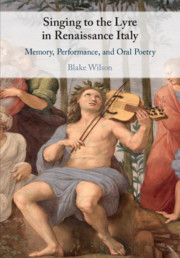Book contents
- Singing to the Lyre in Renaissance Italy
- Singing to the Lyre in Renaissance Italy
- Copyright page
- Contents
- Figures
- Tables
- Acknowledgments
- Abbreviations
- Introduction
- Part I The Canterino Tradition
- Part II Cantare ad Lyram: The Humanist Tradition
- 4 Florence: From Canterino to Cantare ad Lyram
- Excursus 2 Filippino Lippi’s Portrait of a Canterino
- 5 Cantare ad Lyram and Humanist Education
- 6 Cantare ad Lyram in the Courts
- 7 Rome: Cantare ad Lyram at the Summit
- Epilogue The Sixteenth Century
- Bibliography
- Index
7 - Rome: Cantare ad Lyram at the Summit
from Part II - Cantare ad Lyram: The Humanist Tradition
Published online by Cambridge University Press: 31 October 2019
- Singing to the Lyre in Renaissance Italy
- Singing to the Lyre in Renaissance Italy
- Copyright page
- Contents
- Figures
- Tables
- Acknowledgments
- Abbreviations
- Introduction
- Part I The Canterino Tradition
- Part II Cantare ad Lyram: The Humanist Tradition
- 4 Florence: From Canterino to Cantare ad Lyram
- Excursus 2 Filippino Lippi’s Portrait of a Canterino
- 5 Cantare ad Lyram and Humanist Education
- 6 Cantare ad Lyram in the Courts
- 7 Rome: Cantare ad Lyram at the Summit
- Epilogue The Sixteenth Century
- Bibliography
- Index
Summary
Cantare ad lyram reached the summit of its popularity in Rome during ca. 1490–1530. Like the humanist-trained scholars, artists, and clerics who came to Rome from elsewhere, the practice of cantare ad lyram was compelled to adapt to the unique patronage environment of the city, which was distinguished by its emphasis on Latin language, a clerical environment quite unlike the secular world of the courts, and a robust and varied patronage structure. The first part of this chapter is devoted to Latin Rome and focused on the brothers Raffaele and Aurelio Brandolini (including Raffaele’s De musica et poetica, a humanist defense of cantare ad lyram), and on the remarkable Roman banqueting scene that was the city’s primary venue for the elite poetic performances advocated and practiced by the Brandolinis. The second section on vernacular Rome seeks to place the extraordinary singer-poet Serafino Aquilano in the context of the language debates associated with Paolo Cortesi’s Roman Academy, in part through fresh readings of Vincenzo Calmeta’s biography of Serafino, and Angelo Collocci’s Apologia in defense of Serafino’s poetry. The chapter closes with a short study of Raphael’s Parnassus with a view to understanding its relationship to contemporary Roman performance practice of cantare ad lyram.
Keywords
- Type
- Chapter
- Information
- Singing to the Lyre in Renaissance ItalyMemory, Performance, and Oral Poetry, pp. 337 - 405Publisher: Cambridge University PressPrint publication year: 2019



